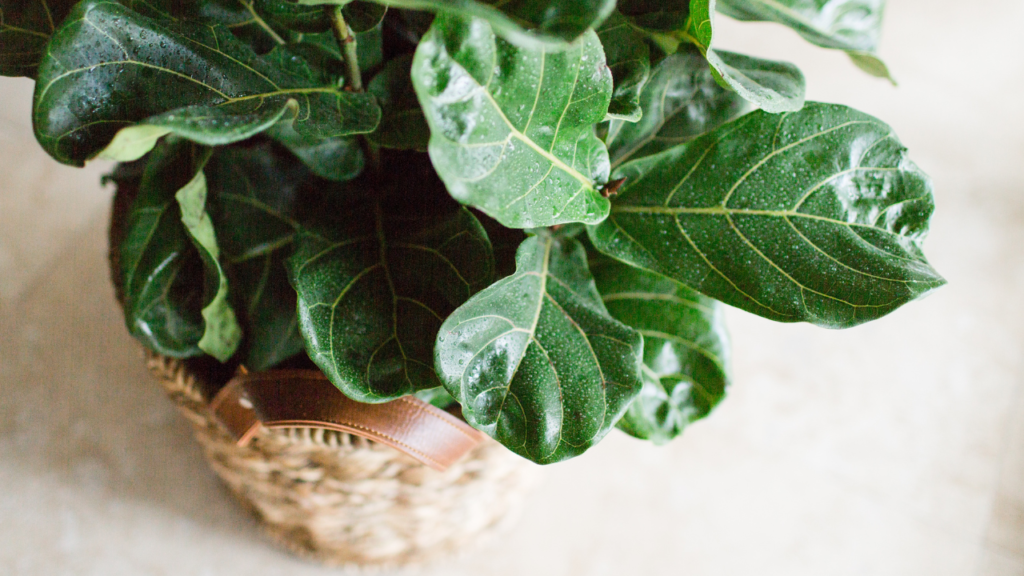The fiddle leaf fig, scientifically known as Ficus lyrata, is a household staple for both seasoned and aspiring plant lovers. Inherently impressive and engaging, this plant not only elevates the aesthetic appeal of homes but also doubles up as a refreshing breath of tropical flair. While this plant is visually appealing, it calls for a bit of understanding and expertise for it to thrive. This guide will delve into the foundations of understanding the fiddle leaf fig plant, by discussing the basic characteristics, growth patterns, and preferred environmental conditions.
We’ll venture into detail on the ideal watering and feeding routines, and learn how to detect and address signs of overwatering or underwatering. Moreover, we will unravel best potting practices and the intricacies of a successful repotting process, helping to ensure that your plant remains stress-free. Lastly, this guide will provide insights on supporting the overall health of your fiddle leaf fig, featuring tips on pruning, disease prevention, and early warning detection.
Understanding Fiddle Leaf Fig Tree Basics
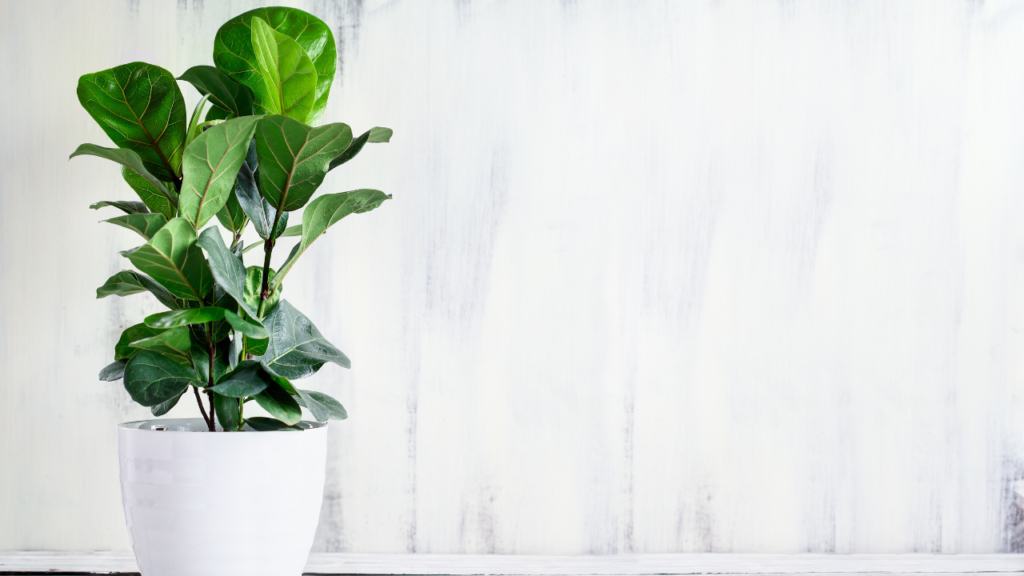
The Fiddle Leaf Fig, also known as Ficus lyrata, is characterized by its large, violin-shaped leaves that don’t shed year-round, thus providing a constant lush green look. Its growth pattern tends to be upright and tall, with a broad canopy. The plant grows naturally in the understory of the tropical rainforests of West Africa, which means it has adapted to survive in low light conditions with high humidity.
Fiddle Leaf Fig – Appearance
Typically, a healthy Fiddle Leaf Fig will grow to around 6 feet indoors. However, with optimum light and space, it can reach heights of up to 15 feet. It sports a slender, tall trunk that’s topped with dramatically veined, glossy, violin-shaped leaves that can grow up to 15 inches long.
Light Requirements for Fiddle Leaf Fig
Being tropical plants, Fiddle Leaf Figs thrive in bright, filtered light. They typically should be placed in a north or northwest-facing window where they can catch the morning light. Although they can grow in lower light conditions, they’ll grow slower and the leaves won’t be as large. You’ll also want to turn the plant every few months once it begins to lean towards the light.
Climate Conditions for Fiddle Leaf Fig
Fiddle leaf figs perform best in warm, humid climates. The ideal temperatures for these plants are between 60-75 degrees Fahrenheit. They don’t do well in cold drafts and sudden temperature changes which can cause them to lose their leaves.
Humidity and Watering Needs
These plants love humidity, so regular misting or placing them on a pebble-filled tray of water can be beneficial. However, they can also adapt to less humid environments. When it comes to watering, keep in mind that Fiddle Leaf Figs have a tendency to develop root rot if overwatered. You should only water your plant when the top couple inches of soil is dry, which will approximately be once every 1-2 weeks.
Space Requirements and Potting Soil
As for the space requirements, a pot of a suitable size should be chosen, keeping in mind the future growth of the plant. The Fiddle Leaf Fig is a slow-growing plant, so it won’t outgrow pots quickly. Additionally, the potting soil should be well-draining. A mix of standard potting soil with a bit of cactus mix or sand would work well. The well-draining soil will help prevent root rot and keep your plant healthy.
Remember to have patience — the Fiddle Leaf Fig can be a bit finicky and temperamental, but with the proper care and attention, its lustrous, sculptural leaves can bring a fresh, verdant touch to any room.
Watering and Feeding Your Fiddle Leaf Fig
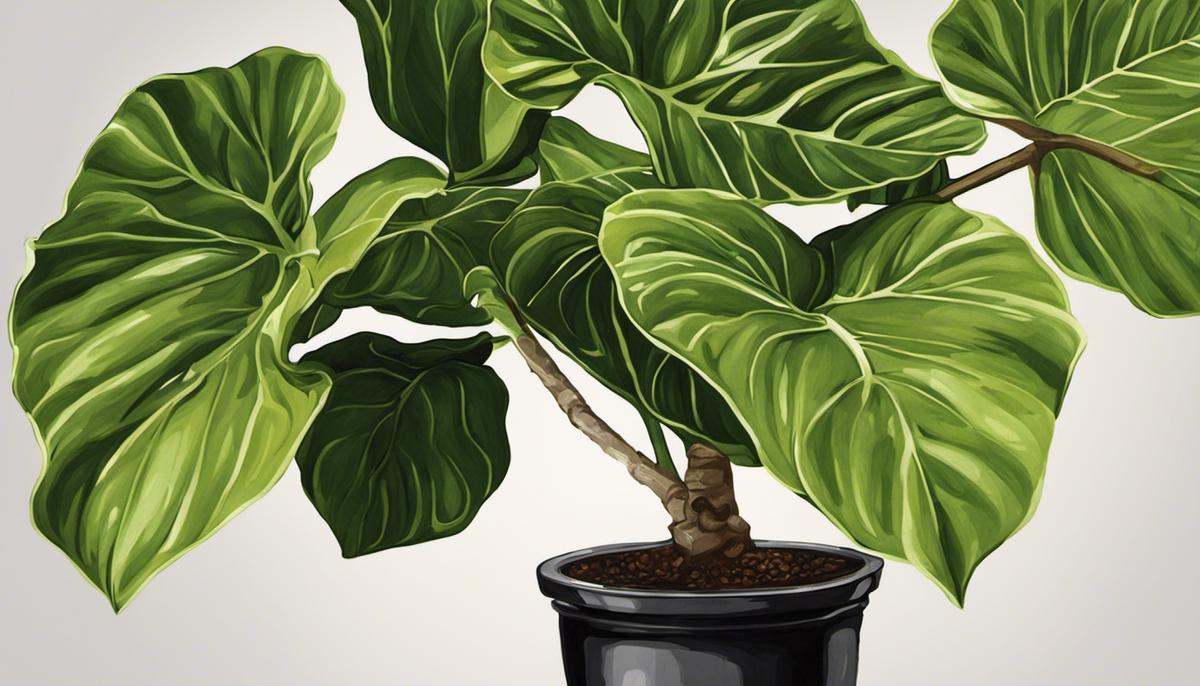
Understanding Your Fiddle Leaf Fig’s Watering Needs
Fiddle leaf figs are tropical plants from the rainforest. They prefer soil that is consistently moist but never waterlogged. In general, the right time to water your plant is when the top inch of its soil is dry. You can test this by sticking your finger into the soil. If the tip of your finger comes out dry, then it’s time to water your fiddle leaf fig.
Watering Techniques
When watering, use tepid, not cold, water to avoid shocking the plant. Make sure to provide enough water to reach the bottom roots. It’s also beneficial to let water run through the drainage holes to flush out salts and minerals that may have accumulated in the soil. After watering, allow the excess water to drain and avoid leaving the plant sitting in water, as this can lead to root rot.
Recognizing Signs of Overwatering and Underwatering
Overwatering is a common problem for fiddle leaf figs. Signs of overwatering include yellow leaves, especially on the lower parts of the plant, and a musty smell indicating root rot. If you notice these signs, hold off on watering until the soil has dried out at least two inches down.
On the other hand, underwatering can cause the leaves of your fiddle leaf fig to turn brown and crispy, usually starting from the edges. If you notice this, increase your watering routine but avoid soaking the plant.
Feeding Your Fiddle Leaf Fig
Besides watering, your fiddle leaf fig also needs regular feeding. You can use a balanced liquid fertilizer. A balanced fertilizer contains similar amounts of nitrogen, phosphorus, and potassium, often listed as a ratio like 10:10:10 or 20:20:20.
When to Feed Your Fiddle Leaf Fig
The best time to feed your fiddle leaf fig is during its growth period, typically from early spring to late summer. Avoid feeding during the dormant winter months, as the plant’s nutritional needs decrease during this period. Apply the fertilizer according to packaging instructions, typically mixing it with water during watering, and avoid overfeeding which can harm the plant.
Choosing the Right Fertilizer
You can use any high-quality indoor plant fertilizer to feed your fiddle leaf fig. However, some gardeners recommend using a fertilizer specifically designed for fiddle leaf figs or other tropical foliage plants, as these formulations contain the right proportions of micronutrients needed for healthy growth. Always follow the manufacturer’s recommended application rates to avoid overfertilization.
These tips should help you manage the water and nourishment your fiddle leaf fig requires. With consistent care, your leafy friend will continue to thrive.
House Plant Essentials
Optimal Potting and Repotting Practices
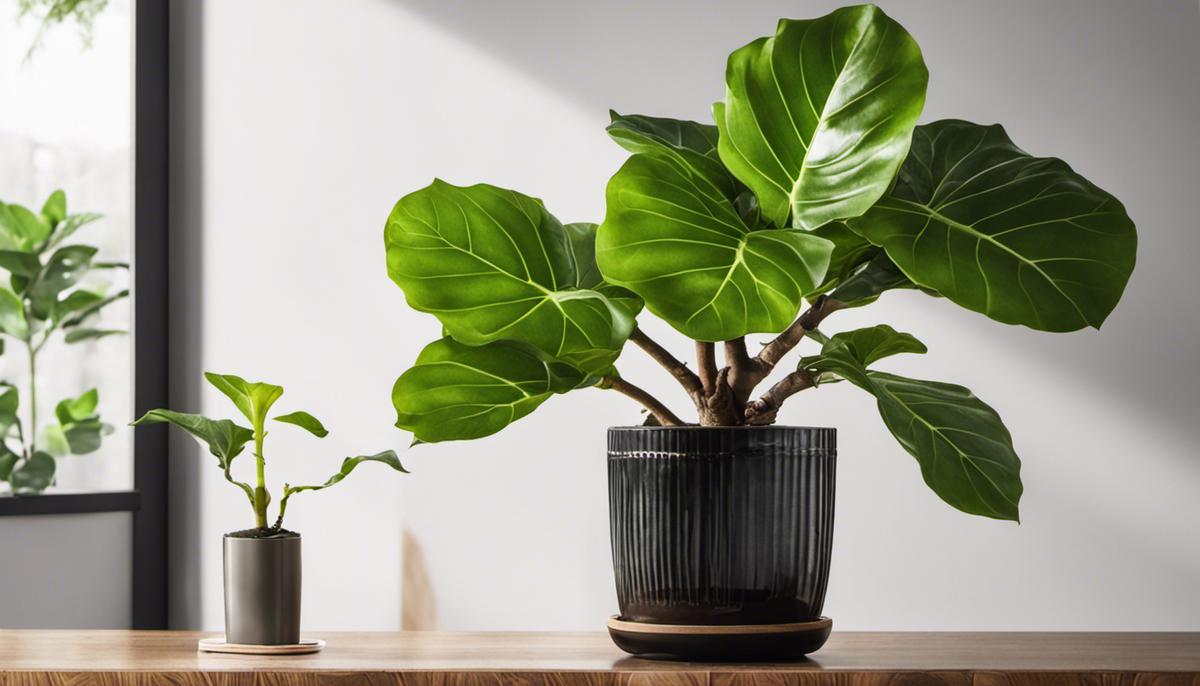
Understanding Fiddle Leaf Fig Soil Needs
Fiddle leaf figs, also known as Ficus Lyrata, thrive best in a well-draining soil mixture for optimal root health. A good rule of thumb is to use a blend of three parts regular potting mix, two parts perlite, and one part orchid bark or coarse sand. This combination typically provides the right balance of moisture retention and drainage, thereby preventing root rot.
Repotting Schedule for Fiddle Leaf Figs
As for when to repot, it is important to pay attention to your fiddle leaf fig’s growth rate and the size of its root ball. Under optimal conditions, these plants can grow quickly, often necessitating a repot every year or two. However, if your plant’s growth has slowed or come to a halt, or if you notice roots poking out from the drainage holes, it’s probably time to repot.
Choosing the Correct Pot Size
When repotting, only increase the pot size by 1-2 inches in diameter. Upgrading to a substantially larger pot can lead to overwatering as the additional soil retains more water. The new pot should have plenty of drainage holes as fiddle leaf figs dislike being water-logged.
The Repotting Process
To repot, carefully remove the fiddle leaf fig from its current pot. Shake off excess soil from the root ball, trim off any brown, mushy roots, and place the plant in the new pot. Add your fresh soil mixture, leaving a gap at the top for watering. Firm the soil lightly with your hands to eliminate any air pockets. Immediately after repotting, give your fiddle leaf fig a deep watering, which can help settle the soil further.
Post Repotting Care
Post repotting, it’s vital to keep an eye on your fiddle leaf fig to ensure it adjusts well to its new home. The relocation may cause a temporary shock to the plant, seen in dropping leaves or slowed growth. Avoid adding fertilizers for about a month post-repotting to minimize stress. Maintain your standard watering schedule, but check for moisture before watering to avoid over saturation. Also, keep your plant in a location with bright, indirect light to support new growth.
<em>By following these simple steps, you can ensure your fiddle leaf fig thrives in its new pot, providing lush, tropical beauty to your space for years to come.
Pruning and Supporting Plant Health
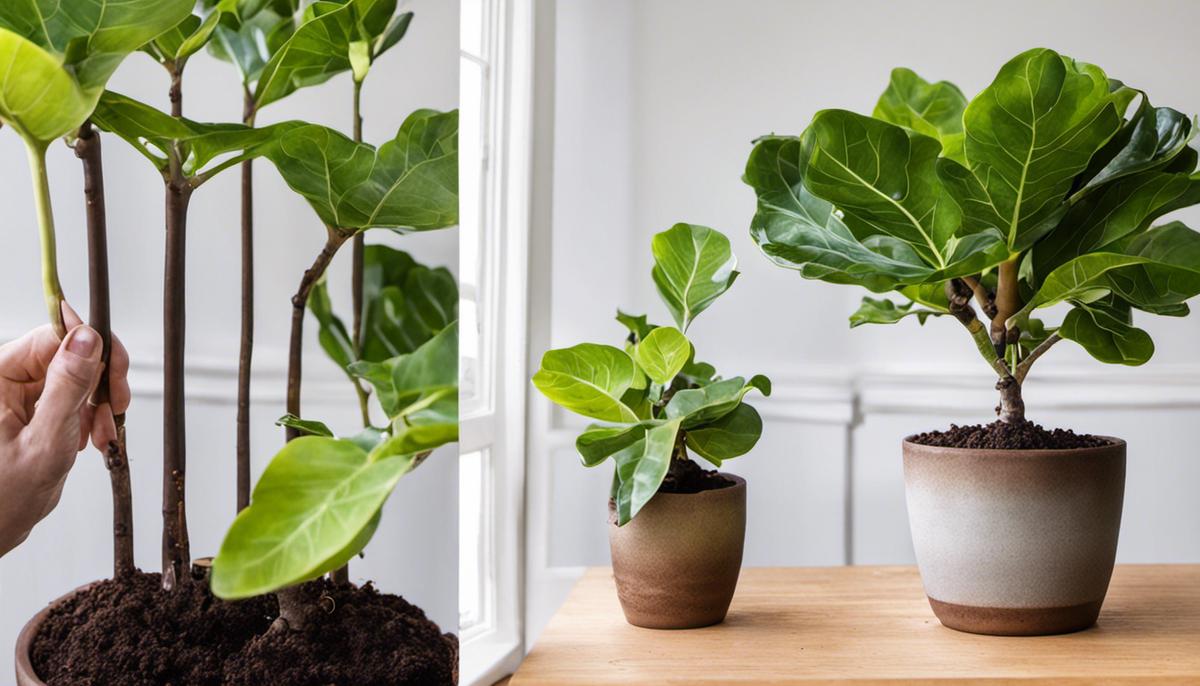
Fiddle Leaf Fig Pruning Instructions
Pruning a Fiddle Leaf Fig promotes healthier growth by allowing vital nutrients to reach the entirety of the plant. Start pruning when the plant is young, directing its growth through judicious cuts that encourage it to grow outwards and upwards. Let’s learn how to do that.
First, identify the areas to prune. These are typically the tallest stalks or overcrowded areas that impede sunlight from reaching the lower leaves. Next, using a sterilized pair of pruning shears, make clean cuts just above the node (where a leaf joins the stem) at a 45-degree angle. This will encourage growth in the desired direction.
Fiddle Leaf Fig Health Support
Disease prevention and proper care are essential for a healthy Fiddle Leaf Fig plant. Regularly wipe down leaves with a damp cloth to keep them free of dust and pests. If underwatered, the plant’s leaves may start to turn yellow and if overwatered, you’ll see brown spots on the leaves. It requires consistently moist (not soggy) soil, so water when the top 1-2 inches of soil feel dry to the touch.
It’s also essential to provide your Fiddle Leaf Fig with plenty of indirect sunlight. Consider rotating the plant every few months to ensure even exposure to the sun.
Detection of Early Warning Signs
Pay close attention to early warning signs such as brown spots, yellowing leaves, or drooping stems. Brown spots may indicate root rot from overwatering, while yellowing leaves may suggest insufficient watering or nutrition.
If the plant begins to droop, it may be lacking light or warmth. Figs are tropical plants and prefer temperatures between 60-75 degrees Fahrenheit. Excessive cold or rapid temperature fluctuations can lead to leaf dropping.
Reacting to Warning Signs
Quickly reacting to these warning signs is crucial for your Fig’s survival. Adjust your watering schedule if you notice yellow or brown leaves. Consider moving the plant to a sunny spot if it’s drooping due to inadequate light. If the temperature is too low, try moving your Fig to a warmer area of your house. Check your plant carefully for pests. They look like tiny brown or black dots on the leaves or stems. Treat any suspected pest infestations with an approved houseplant pesticide or neem oil spray.
Lastly, don’t forget that patience is key.
Your Fiddle Leaf Fig may take time to respond to these changes but remember that slow, steady growth is a sign of a healthy, happy houseplant.
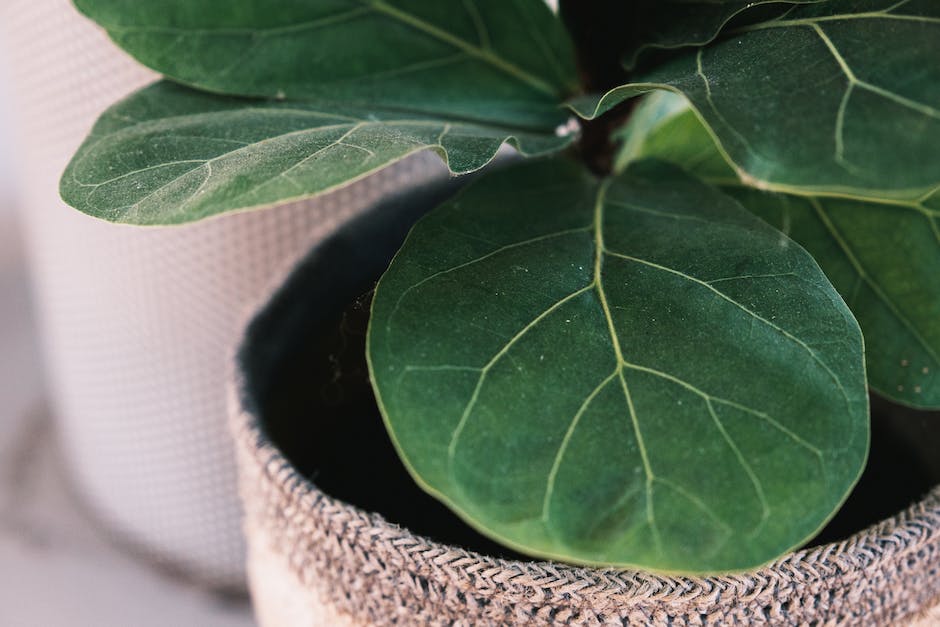
To cultivate a thriving fiddle leaf fig, it’s imperative to possess a sound understanding of the plant’s basics ranging from growth patterns, preferred climate conditions, to typical appearance. Proper watering and feeding routines are key to ensuring the plant’s growth, coupled with implementing the best potting and repotting practices. It’s crucial not to overlook the importance of pruning and providing support for the plant’s general health. That said, observing and reacting appropriately to early warning signs of suffering can make the difference between a flourishing fiddle leaf fig and a struggling one. Although the care process might seem daunting initially, remember that with a bit of dedication, patience, and armed with knowledge from this guide, your fiddle leaf fig will undeniably transform into a breath-taking addition to your home.
